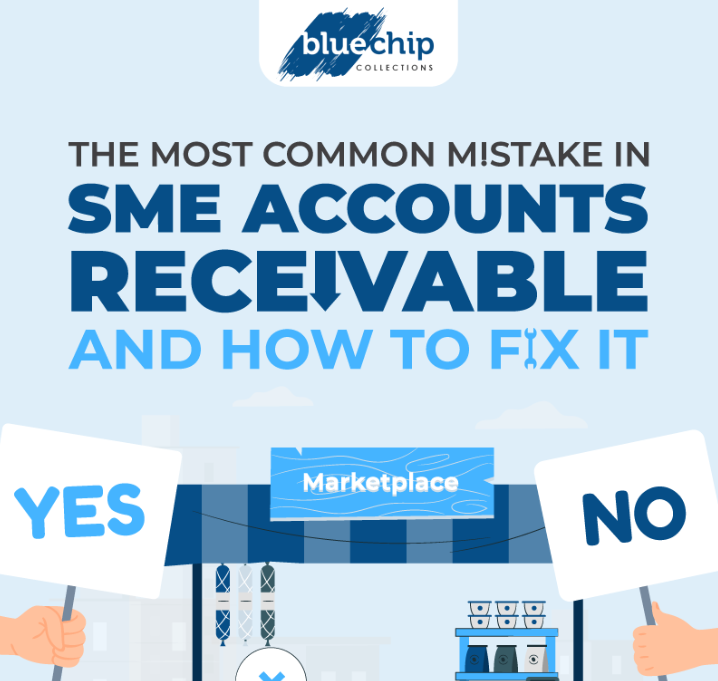Many small and medium-sized enterprises (SMEs) extend credit to customers as part of their growth strategy. Offering credit makes products or services more accessible, strengthens client relationships, and provides a competitive advantage in crowded markets. However, while these advantages can help drive sales, they also come with added responsibility.
Proper management of accounts receivable (A/R)—the outstanding invoices owed by customers—is critical to bridging the gap between sales made and actual cash inflows. When A/R is mismanaged, businesses face delayed payments, tighter liquidity, and unnecessary financial strain. The challenge is not in extending credit itself but in how effectively and efficiently A/R is handled. Recognising these pitfalls early and proactively addressing them allows SMEs to maintain steady operations and support sustainable growth.
Below are the typical accounts receivable mistakes SMEs face and practical ways to fix them.

Mistake 1: Weak Documentation Practices
One of the most common errors is relying on verbal agreements or informal records when dealing with clients. Without clear documentation, disputes become harder to resolve, especially when a customer questions an amount or claims to have already paid. SMEs that do not keep accurate records of contracts, delivery confirmations, and invoices often encounter unnecessary collection delays.
How to fix it:
- Create contracts with detailed service descriptions, agreed rates, and payment schedules.
- Keep signed delivery receipts and link them directly to invoices.
- Use standardised documentation across all transactions to strengthen financial reporting.
Mistake 2: Delayed Follow-Ups on Overdue Accounts
Many SMEs hesitate to follow up on late payments, often out of fear of upsetting client relationships. Unfortunately, the longer a payment stays outstanding, the less likely it is to be collected in full. Late follow-ups can create the impression that payment delays are acceptable.
How to fix it:
- Send payment reminders ahead of the due date and follow up immediately after it passes.
- Escalate accounts that remain unpaid within a set period.
- Consider working with a debt collection company for accounts that are not resolved internally.
Mistake 3: Ignoring Cash Flow Impacts
Late payments create a chain reaction that affects the entire operation. Without consistent incoming payments, businesses may struggle to cover supplier invoices, payroll, and other operational expenses. SMEs that fail to connect A/R performance to cash flow face more than just delayed payments. They jeopardise overall business stability and increase the risk of prolonged financial distress.
How to fix it:
- Review receivables on a weekly basis to spot issues early.
- Offer small early-payment incentives when practical.
- Prioritise recovery on high-value overdue accounts to protect cash flow.
Mistake 4: Overlooking Credit Checks
Some SMEs extend credit without assessing a customer’s payment history or financial health. While it may seem like a quick way to secure a sale, this approach increases exposure to non-payment. Poor credit evaluation often leads to bad debts, which reduce profitability and consume valuable time to resolve.
How to fix it:
- Conduct credit checks on all new customers.
- Request trade references for larger deals.
- Adjust payment terms based on risk levels rather than offering the same arrangement to every client.
Mistake 5: Not Offering Multiple Payment Options
Restricting how clients can pay can delay collections unnecessarily. If a customer must process payments in a way that is inconvenient for them, invoices are more likely to be postponed or forgotten.
How to fix it:
- Accept credit card payments, along with bank transfers and cheques.
- Offer a secure online payment portal for faster processing.
- Provide several payment options to remove barriers to timely payment.
Mistake 6: Neglecting Real-Time Monitoring
Some SMEs still rely on outdated spreadsheets or only review accounts periodically. This reactive approach causes overdue accounts to be flagged too late. Without real-time data, it becomes difficult to spot payment trends or identify high-risk clients before problems escalate.
How to fix it:
- Adopt accounting software with integrated invoicing and A/R tracking.
- Monitor dashboards daily to identify overdue accounts immediately.
- Automate reminders to minimise administrative errors and speed up follow-ups.
Mistake 7: Overlooking Seasonal Risks
Periods like tax season or year-end holidays often disrupt payment schedules. During these times, many clients may prioritise other expenses, leaving invoices unpaid longer than usual. SMEs that do not anticipate these seasonal shifts may experience temporary shortages that strain operations.
How to fix it:
- Analyse past payment patterns to anticipate delays.
- Adjust invoice due dates to avoid predictable slow periods.
- Strengthen follow-up efforts before seasonal disruptions begin.
Mistake 8: Poor Handling of Outstanding Invoices
Some businesses let unpaid accounts linger without escalation. This not only delays recovery but also weakens the company’s position if legal action becomes necessary. When outstanding invoices pile up, staff spend more time chasing old debts instead of focusing on current sales. In fact, 26% of small businesses spend up to an hour each week dealing with past-due invoices.
How to fix it:
- Establish escalation rules for accounts past a certain number of days overdue.
- Move accounts to senior management or external partners when necessary.
- Partner with specialists who recover consumer unpaid debts to improve recovery rates.
Mistake 9: Ignoring the Impact on Financial Stability
Chronic late payments and uncollected invoices do more than create short-term inconvenience—they put financial stability at risk. Businesses relying heavily on credit lines to cover cash flow gaps face rising interest costs and reduced flexibility for future decisions.
How to fix it:
- Set clear, measurable targets for days’ sales outstanding (DSO).
- Track DSO performance monthly and refine collection strategies accordingly.
- Treat A/R management as part of risk control to maintain operational resilience.
Mistake 10: Not Training Staff on Accounts Receivable Mistakes
Even well-designed processes fail if staff are untrained or inconsistent. Miscommunication between sales, billing, and finance teams often results in duplicate invoices, incorrect amounts, or missed follow-ups.
How to fix it:
- Provide training on every stage of the A/R process, from invoicing to account tracking.
- Implement checklists to ensure consistent execution.
- Teach staff how to handle payment conversations professionally to speed resolution.
Elevate Your A/R Management With Bluechip Collection
Accounts receivable management is more than just a back-office function; it directly influences how smoothly an SME operates. By addressing these common mistakes, SMEs can improve financial reporting accuracy, reduce bad debts, and maintain healthier operations.
Effective A/R management gives businesses confidence to grow without worrying about payment delays.
Partnering with Bluechip Collection enables businesses to stay ahead of potential collection issues with professional, reliable, and ethical solutions. Our team specialises in helping SMEs protect their cash flow while maintaining strong customer relationships.
Visit our website at https://bluechipcollections.com.au/ to discover how Bluechip Collection can support your accounts receivable strategy and keep your operations moving forward.



